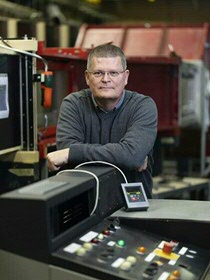Europees octrooi brengt Windenergie-onderzoek aan de RUG verder in stroomversnelling

Prof. dr. Eize Stamhuis van de Rijksuniversiteit Groningen heeft een Europees octrooi gekregen voor een biomimetisch windturbine-design gebaseerd op de vleugels van albatrossen. Biomimetica houdt in dat je de natuur als voorbeeld gebruikt voor technologische oplossingen. Het nieuwe windturbine-design is een resultaat van onderzoek binnen de biomimetica-groep van Prof. dr. Stamhuis in het Energy and Sustainability Research Institute Groningen (ESRIG). Al een aantal jaren doet zijn groep onderzoek naar het verbeteren van de opbrengst van windmolens bij met name lage windsnelheden. Windparken halen nu vaak geen maximaal rendement, omdat de molens vanwege lage windsnelheden vaak een lage efficientie hebben.
Windturbines kunnen bijna de maximaal haalbare energie uit de wind halen als het behoorlijk hard waait. Als er weinig wind is vallen veel molens stil of draaien met maar weinig opbrengst. Deze lage-windsnelheidsperioden komen in ons land vaak voor: een windmolen functioneert wel zeventig tot tachtig procent van de tijd onder zijn beste kunnen.

Oscillerende vleugels
Zeevogels zoals albatrossen en stormvogels kunnen juist heel goed omgaan met lage windsnelheden. Kleinere vogels gaan bij dergelijke omstandigheden harder of anders met hun vleugels slaan om voldoende opwaartse kracht te genereren, maar de vleugels van bijvoorbeeld albatrossen zijn zo lang dat dat niet lukt. Om dit te compenseren laten ze hun vleugels om de lengteas wiebelen, dat heet oscilleren. Door die oscillaties laat de luchtstroom over de vleugel bijna los van het vleugeloppervlak, waarbij de opwaartse kracht juist veel groter wordt. Voordat de stroming helemaal losbreekt 'wiebelt' de vleugel weer terug. Op deze manier worden de piekkrachten tot wel twee keer zo groot en de gemiddelde liftkrachten wel 125 tot 150 procent van de normale kracht.
Dit principe van oscillerende vleugels heeft Stamhuis getest in een stromingskanaal en vervolgens toegepast op windmolens. Bij tests met een relatief kleine windturbine in de windtunnel van ESRIG bleek bij lage windsnelheden zelfs meer dan 200 procent van de normale energie opgewekt te worden als het 'Albatrozz-principe’ werd toegepast.
Patent
De ontdekking werd eerst in een nationaal patent geregistreerd, maar is nu ook in een Europees patent vastgelegd. Daarnaast volgt nog patentering in China. Het principe is niet eerder toegepast op windturbines en er is veel belangstelling voor vanuit de windindustrie. Daarom is er ook een consortium gevormd bestaande uit de RUG en de bedrijven EmpowerMi (Groningen) en RG-Projecten (Leiden). Dit consortium moet de uitvinding in licentie beschikbaar gaan maken voor toepassing op grote windturbines.

Grote schaal
Om de werking ook op grote schaal aan te tonen hopen de onderzoekers binnenkort te gaan testen met twee turbines met een rotor-diameter van 52 meter en een maximaal leverbaar vermogen van 850 kW. Ook zijn er concrete plannen om een spin-off BV op te richten die de vermarkting van licenties voor zowel nieuwe turbines als het verbeteren van bestaande turbines (retrofit) gaat regelen. De onderzoekers hebben al een NWO Take-off grant ontvangen om commercialisering te verkennen en in te zetten.
Meer nieuws
-
19 december 2025
Mariano Méndez ontvangt Argentijnse RAÍCES-prijs
-
18 december 2025
Waarom innoveren, en voor wie?
-
17 december 2025
Ben Feringa wint Feynmanprijs
